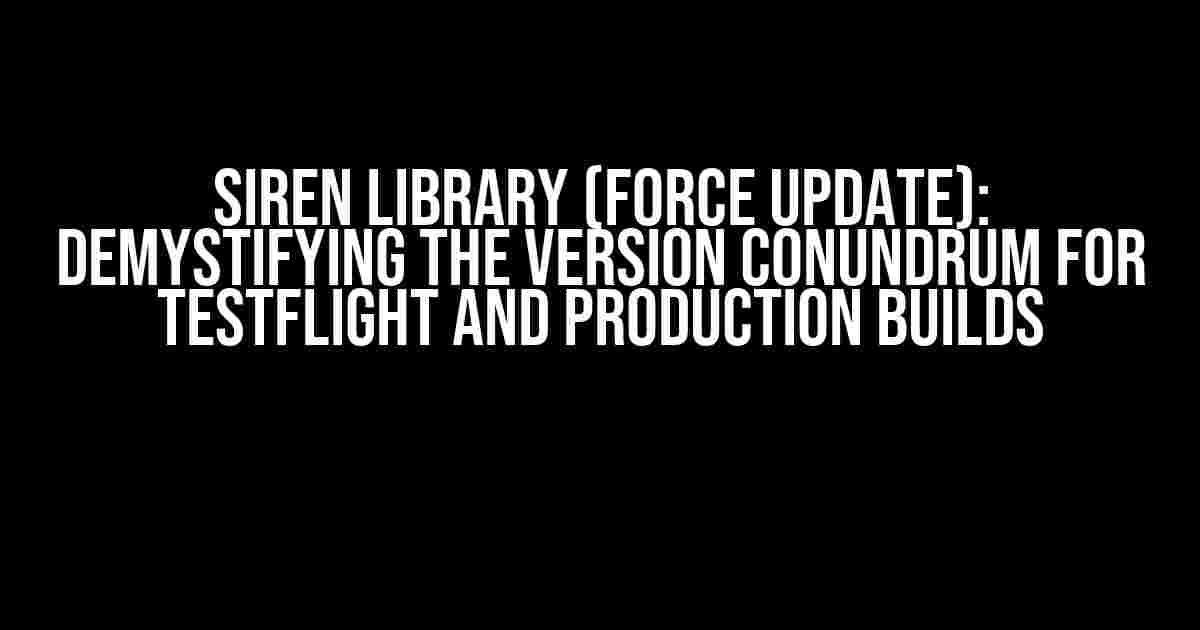Are you struggling to wrap your head around the Siren library’s force update feature and how it relates to versioning for TestFlight and production builds? You’re not alone! In this article, we’ll delve into the nitty-gritty of this often-misunderstood topic, providing clear explanations, and actionable steps to ensure a seamless update experience for your users.
What is the Siren Library?
The Siren library is a popular, open-source framework for iOS and macOS apps that simplifies the process of handling updates, particularly when it comes to forcing users to update to a newer version of your app. This library is especially useful for ensuring that users have the latest security patches, feature updates, and bug fixes.
The Force Update Conundrum
The force update feature is a crucial component of the Siren library. It enables you to specify a minimum required version for your app, ensuring that users are prompted to update to a newer version if they’re running an outdated one. However, this is where things can get a bit murky. You might be wondering:
- Do I need to use the same version for both my TestFlight and production builds?
- What happens if I don’t have the same version for both?
- How do I configure the Siren library to handle versioning correctly?
The Importance of Versioning Consistency
To answer these questions, let’s first discuss the importance of versioning consistency between your TestFlight and production builds. When you upload a build to TestFlight, it’s essentially a beta version of your app that a limited group of users can test before the official release. The production build, on the other hand, is the final, polished version of your app that’s available to the general public.
Here’s the catch: if you don’t use the same version for both your TestFlight and production builds, you might run into issues with the Siren library’s force update feature. This is because the library relies on the app’s version number to determine whether an update is required.
The Risks of Inconsistent Versioning
If you don’t use the same version for both your TestFlight and production builds, you might encounter the following issues:
- False positives: Users might be prompted to update to a newer version of your app even though they’re already running the latest version.
- False negatives: Users might not be prompted to update to a newer version of your app, leaving them vulnerable to security issues or missing out on new features.
- Confusion and frustration: Inconsistent versioning can lead to user confusion and frustration, ultimately damaging your app’s reputation and user experience.
Configuring the Siren Library for Versioning Consistency
To avoid these issues, you should use the same version for both your TestFlight and production builds. Here’s how to configure the Siren library to achieve versioning consistency:
Step 1: Update Your App’s Version Number
Before uploading your build to TestFlight or releasing it to production, update your app’s version number in the Xcode project settings:
// In your Xcode project settings, update the version number
Bundle versions string, short (e.g., 1.2.3)
Step 2: Configure the Siren Library
In your AppDelegate.swift file, import the Siren library and configure it to use the updated version number:
import Siren
// In your AppDelegate.swift file
func application(_ application: UIApplication, didFinishLaunchingWithOptions launchOptions: [UIApplication.LaunchOptionsKey: Any]?) -> Bool {
// Configure the Siren library
Siren.shared.configure(version: "1.2.3")
return true
}
Step 3: Use the Same Version for Both TestFlight and Production Builds
When uploading your build to TestFlight, ensure that the version number matches the production build:
| Build Type | Version Number |
|---|---|
| TestFlight | 1.2.3 |
| Production | 1.2.3 |
Best Practices for Versioning and Force Updates
To ensure a seamless update experience for your users, follow these best practices:
- Use a consistent versioning scheme: Stick to a consistent versioning scheme (e.g., semantic versioning) to make it easier to track updates and changes.
- Test your updates thoroughly: Before releasing an update to production, test it thoroughly in TestFlight to ensure that it’s stable and functions as expected.
- Communicate with your users: Inform your users about the update and what changes they can expect. This can help reduce confusion and frustration.
- Monitor user feedback: Keep an eye on user feedback and reviews to identify any issues or concerns with the update.
Conclusion
In conclusion, using the same version for both your TestFlight and production builds is crucial when working with the Siren library’s force update feature. By following the steps outlined in this article, you can ensure a seamless update experience for your users, reduce false positives and false negatives, and maintain a high level of quality for your app.
Remember to test your updates thoroughly, communicate with your users, and monitor user feedback to provide the best possible experience for your app’s users.
Frequently Asked Question
Got questions about Siren library (Force update)? We’ve got answers! Below, you’ll find the most frequently asked questions about TestFlight and production build versions.
Do I really need to have the same versions for TestFlight and production builds?
Yes, it’s highly recommended to have the same versions for both TestFlight and production builds. This ensures that you’re testing the same build that will be released to the public, avoiding any potential issues or disparities between the two.
What happens if I don’t have the same versions for TestFlight and production builds?
If you don’t have the same versions, you may encounter issues such as inconsistent behavior, crashes, or even rejection from the App Store. This is because the TestFlight version may not be representative of the final production build, which can lead to unforeseen problems.
Can I use different versions for TestFlight and production builds if I’m using Siren?
No, Siren requires that you use the same versions for both TestFlight and production builds. This is because Siren is designed to ensure that your app is updated correctly, and using different versions can cause conflicts and errors.
How do I ensure that I have the same versions for TestFlight and production builds?
To ensure that you have the same versions, make sure to use the same build configuration, archives, and export options for both TestFlight and production builds. You can also use automated scripts and tools to simplify the process and reduce the risk of errors.
What are the benefits of having the same versions for TestFlight and production builds?
Having the same versions ensures that you’re testing the same build that will be released to the public, which reduces the risk of errors, crashes, and inconsistencies. It also saves you time and resources in the long run, as you won’t have to troubleshoot issues that arise from different versions.


